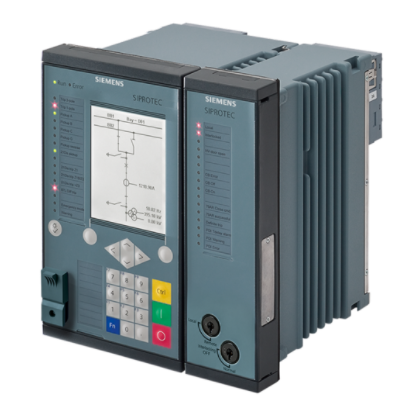
Main function:
- 1 differential protection function (standard) with additional stabilization; up to 3 restricted ground-fault protection functions
- For auto transformer applications 2 differential protection functions can be processed in an auto transformer function group.
- Interoperability of SIPROTEC 5 and SIPROTEC 4 line protection devices for use the line differential protection function in 7UT85,86,87
Useable measuring points:
- 7 x 3-phase current measuring points,
- 7 x 1-phase current measuring points,
- 7 x 3-phase ans 7 x 1-phase voltage measuring points,
- expandable to 4 sides
Inputs and outputs:
2 predefined standard variants with
- 12 current transformers,
- 4 voltage transformers,
- 11 to 23 binary inputs,
- 18 to 34 binary outputs
Hardware flexibility:
- Flexibly adjustable and expandable I/O quantity structure within the scope of the SIPROTEC 5 modular system.
Width of housing:
- 1/2 × 19 inches to 2/1 × 19 inches
DIGSI 5 permits all functions to be configured and combined as required.
- Transformer differential protection for three-winding transformers with versatile, additional protection functions; expandable to four-winding transformers
- Transformer differential protection for phase-angle regulating transformers of the single core type and special transformers
- Universal usability of the permissible measuring points
- Applicable from average up to extra high voltage
- Protection of standard power transformers, auto transformers, short lines, cables, for longitudinal and shunt reactors, as well as motors
- Typical properties of a transformer differential protection such as flexible adaptation to the transformer vector group, control of inrush and overexcitation processes, safe behavior in case of currenttransformer saturation with different degrees of saturation
- Adaptive adaptation of the operate curve to the transformer tap position
- Increased sensitivity with near-neutral-point ground faults through a separate restricted ground fault protection
- Point-on-wave switching
- Additional current and voltage inputs can be supplements for standard protection functions, such as overcurrent, voltage frequency, etc.
- Dynamic Voltage Control (DVC) to adapt the voltage target value via a power direction dependent characteristic curve with strong infeed of regenerative energies
- Graphical logic editor to create powerful automation functions in the device
- Fault locator plus for accurate fault location with inhomogenous line sections and targeted automatic overhead-line section reclosing (AREC)
- Arc protection
- Voltage controller function ANSI 90V for two-winding transformers, three-winding transformers and grid coupling transformers with parallel control (master/follower, circulating reactive current minimization)
- Up to 4 pluggable communication modules, usable for different and redundant protocols (IEC 61850-8-1, IEC 61850-9-2 Client, IEC 60870-5-103, IEC 60870-5-104, Modbus TCP, DNP3 serial and TCP, PROFINET IO, PROFINET IO S2 redundancy)
- Virtual network sharing (IEEE 802.1Q – VLAN)
- Reliable data transmission via PRP and HSR redundancy protocols
- Extensive cybersecurity functionality, such as role-based access control (RBAC), protocolling security-related events, signed firmware or authenticated network access IEEE 802.1X
- Simple, quick and secure access to the device via a standard Web browser to display all information and diagnostic data, as well as vector diagrams, single-line and device display pages
- Secure serial protection data communication, also over great distances and all available physical media (optical fiber, two-wire connections and communication networks)
- PQ-Basic: voltage unbalance; voltage changes: overvoltage, dip, interruption; TDD, THD and Harmonics
- Capturing operational measured variables and protection function measured values for the evaluation of the systems, to support commissioning, and to analyze faults
- Frequency tracked protection functions over a wide frequency range (10 Hz to 90 Hz) and the option to assign the protection functions in a single device to different frequency tracking groups.
- Phasor Measurement Unit (PMU) for synchrophasor measured values and IEEE C37.118 protocol
- Powerful fault recording (buffer for a max. record time of 80 sec. at 8 kHz or 320 sec. at 2 kHz)
- Auxiliary functions for simple tests and commissioning
- Flexibly adjustable I/O quantity structure within the scope of the SIPROTEC 5 modular system








